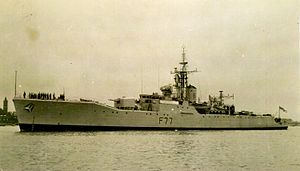HMS Blackpool (F77)
 |
|
| History | |
|---|---|
|
|
|
| Name: | HMS Blackpool |
| Ordered: | 6 March 1951 |
| Builder: | Harland and Wolff, Belfast |
| Laid down: | 20 December 1954 |
| Launched: | 14 February 1957 |
| Commissioned: | 14 August 1958 |
| Out of service: | Leased to the Royal New Zealand Navy between 7 June 1966– 30 June 1971 |
| Identification: | Pennant number: F77 |
| Fate: | Sold for scrapping in 1978 |
| General characteristics | |
| Class and type: | Whitby-class frigate |
| Displacement: | |
| Length: | |
| Beam: | 41 ft (12.5 m) |
| Draught: | 17 ft (5.18 m) |
| Propulsion: | Y-100 plant; 2 Babcock & Wilcox boilers, 2 English Electric steam turbines, 2 shafts, 30,000 shp (22 MW) |
| Speed: | 30 kn (56 km/h) |
| Range: | 370 tons oil fuel, 4,200 nmi (7,780 km) at 12 knots (22 km/h) |
| Complement: | 152, later 225 |
| Sensors and processing systems: |
|
| Armament: |
|
HMS Blackpool was a Whitby-class or Type 12 anti-submarine frigate of the Royal Navy.
Blackpool was leader of the 6th Frigate Squadron between 1958 and 1960. Between 1964 and 1966 she was leader of the 28th Escort Squadron.
She was leased to the Royal New Zealand Navy between 7 June 1966 and 30 June 1971. In 1969, Blackpool was present at the Melbourne-Evans collision.
...
Wikipedia
